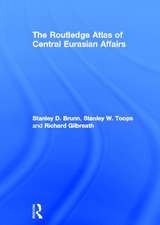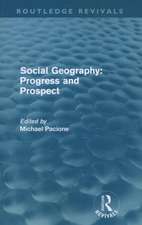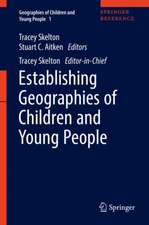Human Dynamics Research in Smart and Connected Communities: Human Dynamics in Smart Cities
Editat de Shih-Lung Shaw, Daniel Suien Limba Engleză Hardback – 22 feb 2018
| Toate formatele și edițiile | Preț | Express |
|---|---|---|
| Paperback (1) | 364.14 lei 38-44 zile | |
| Springer International Publishing – 7 iun 2019 | 364.14 lei 38-44 zile | |
| Hardback (1) | 380.72 lei 38-44 zile | |
| Springer International Publishing – 22 feb 2018 | 380.72 lei 38-44 zile |
Preț: 380.72 lei
Nou
Puncte Express: 571
Preț estimativ în valută:
72.85€ • 76.27$ • 60.28£
72.85€ • 76.27$ • 60.28£
Carte tipărită la comandă
Livrare economică 01-07 aprilie
Preluare comenzi: 021 569.72.76
Specificații
ISBN-13: 9783319732466
ISBN-10: 3319732463
Pagini: 246
Ilustrații: IX, 245 p. 72 illus., 60 illus. in color.
Dimensiuni: 155 x 235 mm
Greutate: 0.57 kg
Ediția:1st ed. 2018
Editura: Springer International Publishing
Colecția Springer
Seria Human Dynamics in Smart Cities
Locul publicării:Cham, Switzerland
ISBN-10: 3319732463
Pagini: 246
Ilustrații: IX, 245 p. 72 illus., 60 illus. in color.
Dimensiuni: 155 x 235 mm
Greutate: 0.57 kg
Ediția:1st ed. 2018
Editura: Springer International Publishing
Colecția Springer
Seria Human Dynamics in Smart Cities
Locul publicării:Cham, Switzerland
Cuprins
Chapter 1. Introduction: Human Dynamics in Perspective (Shih-Lung Shaw).- Chapter 2. Utilizing Geo-Located Sensors and Social Media for Studying Population Dynamics and Land Classification (Gautam Thakur).- Chapter 3. Uncovering the Relationships between Phone Communication Activities and Spatiotemporal Distribution of Mobile Phone Users (Yang Xu).- Chapter 4. Spatiotemporal-Network Visualization for Exploring Human Movements and Interactions in Physical and Virtual Spaces (Song Gao).- Chapter 5. Modeling Mobility and Dynamics of Scheduled Space-time Activities - an RDF Approach (Junchuan Fan).- Chapter 6. Smart Sensors, Cyborgs, and Cybernetics: A Critical Reading of Smart City Technologies (Chen Xu).- Chapter 7. A Location-Based Client-Server Framework for Assessing Personal Exposure to the Transmission Risks of Contagious Diseases (Tzai-Hung Wen).- Chapter 8. An Exploratory Analysis of the Effects of Spatial and Temporal Scale and Transportation Mode on Anonymity in Human Mobility Trajectories (Jennifer A. Miller).- Chapter 9. Uncovering Geo-Social Semantics from the Twitter Mention Network: An Integrated Approach Using Spatial Network Smoothing and Topic Modeling (Caglar Koylu).- Chapter 10. Grouping People in Cities: From Space-Time to Place-Time Based Profiling (Tao Cheng).- Chapter 11. Open Source Social Network Simulator Focusing on Spatial Meme Diffusion (Xinyue Ye).- Chapter 12. The Challenges and Opportunities with Social Media and Big Data for Research in Human Dynamics (Atsushi Nara).- Chapter 13. Outlook and Next Steps: From Human Dynamics to Smart and Connected Communities (Daniel Sui).
Notă biografică
Shih-Lung Shaw is Alvin and Sally Beaman Professor and Arts and Sciences Excellence Professor of Geography at the University of Tennessee, Knoxville. He also serves as the interim associate provost for international education at the University of Tennessee, Knoxville. He received his B.S. degree from the National Taiwan University and his M.A. and Ph.D. degrees from the Ohio State University. His research interests cover geographic information science (GIScience), transportation geography, time geography, GIS for transportation (GIS-T), and space-time analytics of human dynamics. His recent research has focused on space-time analytics of human activities and interactions in a hybrid physical-virtual world based on various types of individual tracking data such as cell phone data, online social media data, vehicle tracking data, travel-activity survey data, and population migration data. His research has led to the development of a space-time GIS for representation, analysis, and visualization of individual activities and interactions in a hybrid physical-virtual space. Dr. Shaw is a Fellow of the American Association for Advancement of Science (AAAS). He also received the Edward L. Ullman Award for Outstanding Contributions to Transportation Geography from the Association of American Geographers (AAG) and served as the Head of the Department of Geography at the University of Tennessee, Knoxville.
Daniel Sui is an Arts and Sciences Distinguished Professor and Professor of Geography, Public Affairs, Public Health, and Urban/Regional Planning at the Ohio State University (OSU). He also serves as the Division Director for Social and Economic Sciences(SES) at the U.S. National Science Foundation. Prior his current appointment, professor Sui served as Chair of Geography (2011-2015) and as Director of the Center for Urban & Regional Analysis (CURA) (2009-2012) at OSU. Before joining the faculty of OSU in July 2009, Daniel Sui was a professor of geography (1993-2009) and holder of the Reta A. Haynes endowed chair (2001-2009) at Texas A&M University. He holds a B.S. (1986) and M.S. (1989) from Peking University and Ph.D. from University of Georgia (1993). His research current interests include GIScience and cartographic theory, location-based social media, open/alternative GIS, Deep Web/Darknet, and legal/ethical issues of using geospatial technology in society. Sui was a 2009 Guggenheim Fellow, 2006 winner of the Michael Breheny Prize for best paper in Environment and Planning, and 2014 recipient of the distinguished scholar award from the Association of American Geographers. Sui was also the 2015 Public Policy Scholar in residence at the Woodrow Wilson International Center for Scholars. He served on the U.S. National Mapping Science Committee for two terms (2007-2013) and currently serves as editor-in-chief for GeoJournal.
Daniel Sui is an Arts and Sciences Distinguished Professor and Professor of Geography, Public Affairs, Public Health, and Urban/Regional Planning at the Ohio State University (OSU). He also serves as the Division Director for Social and Economic Sciences(SES) at the U.S. National Science Foundation. Prior his current appointment, professor Sui served as Chair of Geography (2011-2015) and as Director of the Center for Urban & Regional Analysis (CURA) (2009-2012) at OSU. Before joining the faculty of OSU in July 2009, Daniel Sui was a professor of geography (1993-2009) and holder of the Reta A. Haynes endowed chair (2001-2009) at Texas A&M University. He holds a B.S. (1986) and M.S. (1989) from Peking University and Ph.D. from University of Georgia (1993). His research current interests include GIScience and cartographic theory, location-based social media, open/alternative GIS, Deep Web/Darknet, and legal/ethical issues of using geospatial technology in society. Sui was a 2009 Guggenheim Fellow, 2006 winner of the Michael Breheny Prize for best paper in Environment and Planning, and 2014 recipient of the distinguished scholar award from the Association of American Geographers. Sui was also the 2015 Public Policy Scholar in residence at the Woodrow Wilson International Center for Scholars. He served on the U.S. National Mapping Science Committee for two terms (2007-2013) and currently serves as editor-in-chief for GeoJournal.
Textul de pe ultima copertă
This book addresses how accelerating advances in information and communication technology, mobile technology, and location-aware technology have fundamentally changed the ways how social, political, economic and transportation systems work in today’s globally connected world. It delivers on many exciting research questions related to human dynamics at both disaggregate and aggregate levels that attract the attention of researchers from a wide range of disciplines. Human Dynamics Research involves theoretical perspectives, space-time analytics, modeling human dynamics, urban analytics, social media and big data, travel dynamics, privacy issues, development of smart cities, and problems and prospects of human dynamics research. This book includes contributions on theoretical, technical, or application aspects of human dynamics research from different disciplines. Appealing to researchers, scholars and students across a wide range of topics and disciplines including: urban studies, space-time, mobility and the internet, social media, big data, behavioral geography and spatiotemporal-network visualization, this book offers a glimpse at the cutting edge of research on human dynamics.
Caracteristici
The first book to cover cutting edge research on human dynamics in smart/connected communities Brings together a leading group of interdisciplinary scholars to address smart technologies for human dynamics Critically examines human dynamics in smart/connected communities from a comprehensive spatial-temporal perspective
























